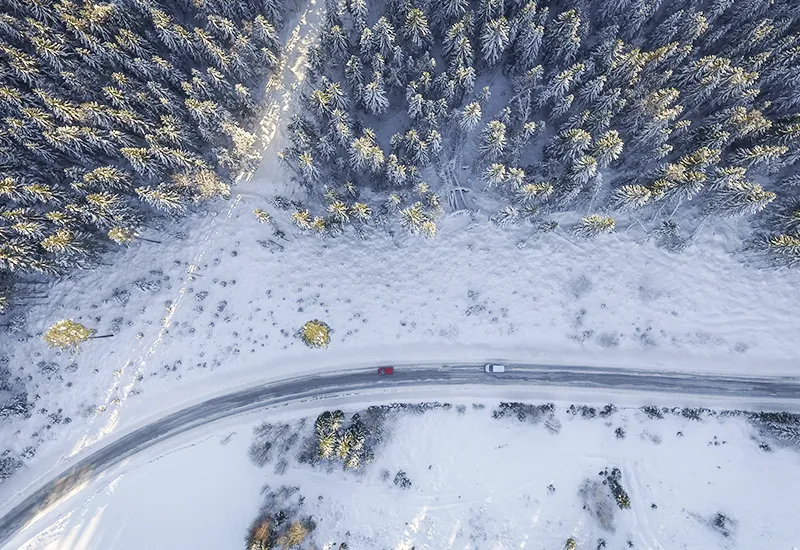How can electric cars be used as efficiently as possible in winter and increase their range? If you're looking for a clear answer to this question, you've come to the right place!
Most electric car drivers are literally caught cold in the winter season because their vehicle no longer has the usual range. This is because electric vehicles are actually slightly less powerful than combustion engines in the cold season, as the battery discharges more quickly.
Fortunately, however, you can play a decisive role in ensuring that the loss of range is only minimal and that you can drive significantly longer and further.
In this article, I will therefore present the most important tips for using electric cars in winter - and show you how you can specifically increase their range. Let's go!
Background: Why do electric cars have a shorter range in winter?

There really are a lot of Myths and misconceptions about electric carswhich can be quickly refuted. However, the fact that electric cars have a shorter range in sub-zero temperatures than in the warm summer months is unfortunately a logical truth.
Logical, because the The colder the environment, the lower the energy consumption of batteries. You may be familiar with this from your smartphone battery, which drains more quickly in winter.
In addition, experience has shown that the vehicle is also subjected to a Higher heat output in the interior required. As the motor does not generate any waste heat, not only more, but almost all of the power for this must ultimately be used from the electric battery.
For these reasons, electric cars in winter according to the ADAC, an average of around 20-30 percent higher consumption. For example, anyone who regularly drives many short distances a day at -7 °C would lose around 50 percent of the vehicle's actual range.1
10 tips: What can you do to give electric cars more range in winter?

Let's not misunderstand each other: Electric cars have countless advantages! For example, you drive emission-freeare quiet and do not stink, become State-subsidized and you can Charge at home at the wallbox. However, the reduced range in cold weather is one of their most valid disadvantages - I can confirm this from my own experience.
Aaaaabut! Already with some simple measures, tips and tricks we drivers can increase the range of our electric cars in winter so that we hardly notice any difference to using them at higher outside temperatures. Here I present them to you now.
1. control the charging time with charging control
Most electric cars have a charging control system. You can use this to determine exactly when you want to set off in your electric car. The battery is then charged in such a way that the charging process is only completed shortly before departure so that it is warmed up at the required time and more powerful is. You can also take into account that the charging time is longer in cold temperatures.
You can also use the charge control system to set the Regulating the parking heaterto find the interior already preheated.
2. heat correctly
In a car with an internal combustion engine, the engine heats the cooling water, which then heats the air inside the car via a heat exchanger. The e-car does not have this function. This is why the electricity from the battery is needed to heat the air in the car.
However, when it comes to heating processes, there are some natural measures you can take to save electricity. General tips I have compiled a clear overview for you here:
- Do not heat the interior of your electric car during the journey, but before it starts (usually also works via smartphone) if the car is still connected to the power grid. The electricity then comes from the socket and does not affect the range. A decisive advantage of electric cars.
- Use the savings function if possiblewhich only heats the driver's area and not the entire interior if you are only driving your electric car alone anyway.
- Heat with circulating air, but set the interior heating slightly lowerdress a little thicker and prefer the heated seats and steering wheel, as well as the heated bars in the windshield, which require much less energy.
3. drive with foresight
Both in summer and winter, you can use the Also influence range via your driving behavior. To maximize the distance, it is advisable to drive with foresight: The less you have to brake and accelerate again, the more energy you can save while driving.
So always pay attention to the traffic and, for example, watch traffic lights from a greater distance so that you avoid unnecessarily hard braking. Keeping a sufficient distance from the car in front of you is also a tried and tested means of driving more powerfully and therefore more safely. drive a car more sustainably.
Another tip for more range in winter is also a Forward-looking planning of your trips. You should avoid too many short journeys with long interruptions (during which the battery cools down again).
You don't have to worry about getting stuck in a traffic jam on the highway, by the way, because the Battery does not suddenly fail completely. Nevertheless, you should of course keep an eye on the power consumption of your electric car - just like the fuel consumption of the combustion engine.
4. choose the right tires and increase tire pressure
For the cold season, we recommend the following for your electric car small rims and winter tires with low rolling resistance. In addition, a slightly higher tire pressure increase the range in winter. However, make sure you do not exceed the maximum tire pressure specifications.
5. parking and charging in the garage

If the outside thermometer indicates sub-zero temperatures, it is advisable to always park the electric car in a garage, so that the battery does not cool down too much. Ideally, you can also charge them there directly at a wallbox or charging station. If the battery is at operating temperature immediately after the journey, the charging capacity is conveniently higher.
If this is not possible, you can of course also park your electric vehicle outside, as the Insulation on the battery prevents it from cooling down completely in winter temperatures. However, you must of course expect that the Charging process takes a little longerthan in summer.
6. switch on Eco mode
Many electric cars have a kind of environmental mode that you can switch on to ensure a low noise level while driving. Maximum efficient energy control and much Save electricity.
When Eco mode is activated, the motor of your electric car transmits less power to the wheelsto achieve a greater range. For example, the heat output is reduced.
Your electric car will also start more slowly and accelerate more slowly - i.e. without spinning wheels. The driving pleasure may suffer somewhat as a result, but especially In winter road conditions, it makes perfect sense toto be a little more careful on the road. In order to cover the greatest possible distances, you really also need to switch on the "eco mode in your head." 😉
7. charge the battery correctly
Regardless of the outside temperature, you should avoid draining the battery completely or keeping it at 100 percent. An optimal, Battery-saving charge level is between 20 and 80 percent.
In winter, it is most gentle if you use the Charge the battery directly after each journeyas it is still warm. This increases the service life of the battery, but also shortens the charging process.
To protect the battery, you should If possible, do without fast charging more often. This is because it has to absorb a lot of energy in a short space of time - especially in cold temperatures, this can cause the battery to heat up considerably and put a strain on it. Instead, charge your e-car at home overnight or at work while you're at work.
8. use heat pump
There are now several Electric cars with heat pumps (e.g. the Audi e-tron, the BMW i4 or the Peugeot e208), which reduce the load on the battery and regulate the interior temperature. As in residential buildings, the heat pump extracts heat from the environment, which is then released as heating energy via a heat exchanger.
It can even be retrofittedif it is not fitted as standard in your electric car model. If the longest possible range of your electric car in cold weather is very important to you, the investment can definitely be worthwhile for you - and the environment.
9. saving electricity in traffic jams
Getting caught in a traffic jam is always annoying - but especially when you are traveling with your drive an electric car and whose range is lower in winter anyway. To prevent the loss of range, you can, for example, use the Switch off the seat heating and the front and rear window heating and also turn the interior heating down a little.
Also make sure that windows and doors are not left open for too longso that the heat generated remains in the car and the heater does not have to fight against the cold outside temperatures. (this is also the case with the refrigerator)
You can also save some electricity if you switch from low beam to parking lights during the traffic jam. But safety comes first here: If visibility is poor, leave the dipped headlights on so that your car can still be seen by other road users.
10. use recuperation

When you take your foot off the accelerator and let the electric car roll, the Recuperation in: The The motor then becomes a generator and produces energywhich is used to recharge the battery while driving.
However, if the battery in your electric car is cold in winter, the energy recovery via However, experience has shown that recuperation is somewhat weaker off. This ultimately also has an effect on the range and can also be noticeable through a change in braking behavior.
Increase the range of electric cars in winter with simple tips & tricks
At sub-zero temperatures, the battery of the electric car is less efficient and takes longer to fully charge. Unfortunately, this is the case.
However, to minimize the impact of this not insignificant disadvantage on the range, you should Among other things, make sure to charge your vehicle with a preheated battery and to consume less electricity during the journey, for example for heating. In addition, an anticipatory driving style is essential in order to conserve battery capacity.
"Without the cold and desolation of winter there could not be the warmth and splendor of spring."
Ho Chi Minh (more under Winter Quotes)
When saving energy, however, remember that safety always comes first - for example, if you want to save electricity on heating, this is only possible if all windows are free of ice and fogging. You should also never save on lighting when visibility is poor.
Do you have any questions, suggestions or other tips for using electric cars on cold winter days in snow and ice? Then I look forward to your experiences and ideas in the comments.
Stay sustainable,

PS: By the way, your electric car is particularly eco-friendly if you can power it at home with electricity from renewable energies that you create yourself. If you want to know more about this, then take a look at my article on Solar energy.
References
- Allgemeiner Deutscher Automobil-Club e.V. (ADAC): Elektroauto im Winter - So massiv sinken die Reichweite bei Kälte (as of 01.03.2022), available at https://www.adac.de/rund-ums-fahrzeug/elektromobilitaet/info/elektroauto-reichweite-winter. [14.11.2023]. ↩︎









